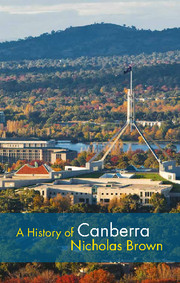8 - Feel the power
Published online by Cambridge University Press: 05 July 2014
Summary
AN URBAN VILLAGE
In the optimism of the mid-1960s, the National Capital Development Commission (NCDC) had envisaged Canberra’s population in 1990 as 500 000. When that year came, the figure was 282 600. Such a shortfall indicates the scale at which visions, and realities, of the city had changed. Briefly, in the mid-1980s, buoyed by a new federal government, the NCDC had been lured back to that half million possibility as a goal to welcome the new millennium – but that was still with a faith that the tasks of national development would inevitably deliver such growth to the capital. By 1990, with the coming of self-government and the end of a deregulation-driven boom grinding into Federal Labor Treasurer Keating’s ‘recession we had to have’, it was clear that Canberra might instead be left to its own devices. The city, as demographers calculate, might then have been on the verge of that long-anticipated threshold at which its size would finally be sufficient to underpin its development. But a number of trends were suggesting that the seeds for such development were fouling. The future to be raised from them might not be pretty.
In 1990, estimates of the Australian Capital Territory’s employment growth were nearly halved to 2.8 per cent for the next five years. From 1994 to 1998 its economic activity grew at 1.7 per cent while the Australian average was three times that. Between 1994 and 2006, its population grew at levels consistently below the national rate (0.9 as against 1.3 per cent). When the new millennium came, estimates were for 390 000 residents by 2030; the figure of 500 000 was deferred to 2050. Statistics are not a story in themselves, but they suggest a framework. Having passed through the politicisation of the 1970s and 1980s, the adjustment of expectations, usually downwards, became the overarching priority for a city continuing to find its scale and place in the dynamics of the nation around it.
- Type
- Chapter
- Information
- A History of Canberra , pp. 222 - 246Publisher: Cambridge University PressPrint publication year: 2014



